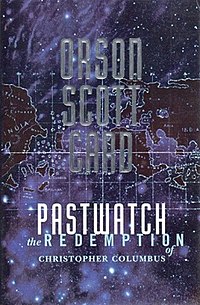Pastwatch: The Redemption of Christopher Columbus
by Orson Scott Card
Sometime in the future, humanity invents a series of machines which allow them to view events in their past. Tagiri is a researcher at Pastwatch, the organization in charge of these machines. Her special interest is in the colonization of the Caribbean and the life of Christopher Columbus. One day she accidentally discovers that the machines may be used to send information backwards in time. Unsure about what to do with this knowledge she is nonetheless put in charge of a project to explore it along with her husband Hassan. They are eventually joined by their daughter Diko.
A parallel narrative tells of Columbus' efforts to secure financial and political backing for his voyage across the Atlantic. Tagiri and other researchers note that Columbus had always yearned for greatness but that as a young man he had been determined to head east in a new Crusade to liberate from the Muslims the Holy Land as well as Constantinople, whose fall was a recent and painful event to Europeans of Columbus' generation. Columbus only changed his mind and decided to head west across the Atlantic after nearly drowning in a storm.
The mystery of exactly why Columbus changed his mind is solved by Diko. She uses a new, and more visually sensitive, version of the time viewer and discovers that after surviving the wreck Columbus received a vision directing him to head west to convert the people who lived on a previous undiscovered continent. The researchers realize that this vision is actually a hologram sent back in time by people from an alternate timeline in order to influence the direction of Columbus' life.
Realizing that someone has already changed the timeline they try to figure out what might have been different if Columbus had headed east instead of west. The answer is provided by Hunahpu, an Amerindian researcher with Pastwatch. He argues that in the original timeline, the Europeans exhausted themselves in the anti-Muslim crusade propagated by Columbus, and meanwhile across the ocean the Tlaxcalan Empire of Central America grew powerful enough to invade the weakened Europe, subjecting the continent to a harsh regime of human sacrifice. Eventually, the Tlaxcalans underwent an Industrial Revolution and developed advanced weapons which enabled them to conquer the entire world - still without changing their bloodthirsty religion. In order to undo that atrocity, the Pastwatch's counterparts from the original timeline sent the hologram back to direct Columbus, the greatest man of his era, to head west. The European conquest of the Americas thereby neutralized the threat - but at the price of untold suffering for the Native Americans, trampled under the European conquest.
Tagiri and her team determine that they must change history so that neither timeline happens as it did. The urgency of doing so increases when Tagiri's world goes into an ecological disaster of untold proportions, which threatens the very survival of humanity. Tagiri and the others reason that the ruthless plundering of the world's resources which led to the disaster was a continuation of the dynamic of ruthless European conquest of the Americas, and averting the one might avert the other as well. In any case, with the world on the brink of total disaster, there is little to lose in interfering with history and trying to change and improve it.
Tagiri's team use their machinery to send Diko, Hunahpu, and a Turkish researcher named Kemal, back in time in order to change history. Hunahpu and Diko appear years before Columbus' voyage in Central America and the Caribbean respectively. They use genetically-engineered viruses to spread immunity to Old World diseases and work to strengthen Indian society for the coming European contact, including by spreading a pseudo-Christian religion among them and outlawing human sacrifice. Hunahpu helps accelerate the development of a Central American empire to rival European powers. When Columbus arrives, Kemal sinks his ships, stranding the explorer and his men in the Caribbean. After overcoming prejudice, Columbus learns to live with the indigenous people and becomes a powerful political leader among the natives of the Caribbean and eventually oversees a political union with the Central American empire.
Diko becomes Columbus' lover and the two establish a strong, lasting loving relationship. After years of their knowing and trusting each other, Diko reveals to Columbus the truth about her origins and what she had done. When hearing about how his voyage of discovery would have led to the widespread killing and enslavement of the Indians, Columbus bursts out crying and thanks Diko for saving him from perpetrating such deeds.
By the sixteenth century, the people of Central America and the Caribbean are able to send ships across the Atlantic to meet the Europeans on more equal footing. Neither Europeans nor Native Americans are in a position to conquer the other, and they embark on reasonably peaceful relations.
A postscript describes the future of this new timeline as a utopian one and how archeologists in the 1950s discovered the skull of Kemal and found within it a set of small metal plates which contained a message from Tagiri and the Pastwatch program.
